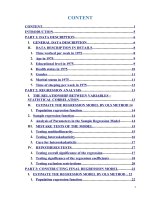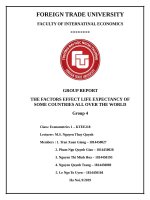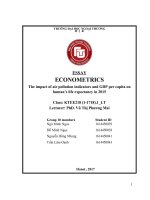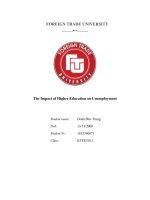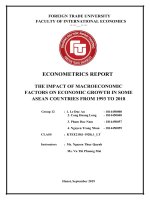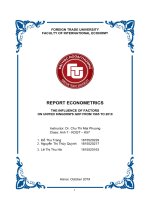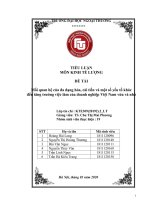tiểu luận kinh tế lượng THE FACTORS AFFECTING THE QUANTITY OF VIETNAM’S TIMBER AND WOODEN PRODUCTS EXPORTED TO FOREIGN NATIONS
Bạn đang xem bản rút gọn của tài liệu. Xem và tải ngay bản đầy đủ của tài liệu tại đây (2.11 MB, 63 trang )
FOREIGN TRADE UNIVERSITY
FACULTY OF INTERNATIONAL ECONOMICS
********
FINANCIAL ECONOMETRICS REPORT
THE FACTORS AFFECTING THE QUANTITY OF
VIETNAM’S TIMBER AND WOODEN PRODUCTS
EXPORTED TO FOREIGN NATIONS
Class: Financial Econometrics KTEE310.1
Lecturer: MSc. Nguyen Thuy Quynh
Members: 1. Vu Phuong Anh – 1813340009
2. Pham Bui Hanh Duyen – 1813340020
3. Nguyen Phan My Duyen - 1816340018
4. Dong Nguyen Thanh Hai – 1810340001
5. Nguyen Quynh Nga – 1813340042
Ha Noi, 12/2019
ABSTRACT.................................................................................................................1
INTRODUCTION.......................................................................................................2
SECTION I: OVERVIEW OF THE TOPIC................................................................3
SECTION II: MODEL SPECIFICATION................................................................14
1.
Methodology..............................................................................................14
2.
Theoretical model specification................................................................14
3.
Describe the data.......................................................................................16
SECTION 3: ESTIMATED MODEL AND STATISTICAL INFERENCES................37
1.
Estimated Model.......................................................................................37
2.
Diagnosis Testing.......................................................................................39
3.
Hypothesis Testing.....................................................................................45
4.
Recommendation.......................................................................................50
CONCLUSION..........................................................................................................52
REFERENCES..........................................................................................................54
APPENDIX 1.............................................................................................................55
APPENDIX 2: DO-FILE...........................................................................................59
3
ABSTRACT
The scope of our research regards factors that might have momentous impacts on the
quantity of Viet Nam’s timber and wooden products being exported to foreign nations.
The panel analysis within our project was carried out using data from different
countries (Germany, Netherlands, USA, Japan, England, France, …) in the period
from 2001 to 2016. There are 5 elements being researched in our data, including the
quantity of Viet Nam’s timber being imported by other countries, the population,
timberland, GDP of import countries and the geographical distance from Viet Nam to
these countries.
We genuinely conducted a wide variety of tests so as to evaluate the importance of the
examined elements to Viet Nam’s wood exports. The tests we used are hypothesis
testing, diagnosis testing, …
Ultimately, the results have shown that there is seemingly a close correspondence
between the aforementioned independent variables and the explained variable.
Thanks to the adequate and comprehensive tests as well as sufficient data collecting,
our group were capable of acquiring a more extensive knowledge about the economy
in general and Viet Nam’s timber exports in specific. We can also develop a further
understanding over the disturbances that contribute to the fluctuation of Viet Nam’s
timber exports. Consequently, Viet Nam’s government is now able to impose radical
and plausible policies to our timber industry based on the collected data as well as
conducted tests.
4
INTRODUCTION
Nowadays, in our contemporary society, wooden products have become truly intimate
and crucial to our lives. It is indisputable that everyone loves wooden floors, wooden
furniture and so on. Unlike some developed nations, Viet Nam has the merits of the
vast area of forest, and an ancient timber industry. In fact, our craftsman are capable of
making really sophisticated and brilliant products, albeit not as ingenious and
luxurious as some countries. Nonetheless, our products still yield a surprisingly well
finish and quality with a decent price. Hence, Viet Nam’s economy in recent years
witnessed a proliferation in the timber industry, with the prosperity of numerous wood
companies. Nonetheless, our timber exports do have some significant fluctuations
sometimes. Subjectively speaking, there must be some addressable reasons for this
phenomenon.
Inevitably, in order to ensure our timber industry’s development and our wood exports,
it is of importance to figure out this phenomenon’s dominant justifications.
Having researched about Viet Nam’s wood industry, we assume that there are elements
attributing to those unstable exports. We examined this assumption with the tools
provided from econometrics and the software STATA. Our model includes five
variables, one is the dependent variable (Viet Nam’s timber exports) and the rest are
independent variables (the quantity of Viet Nam’s timber being imported by other
countries, the population, timberland, GDP of import countries and the geographical
distance from Viet Nam to these countries). We hope that these variables will be
sufficient for our research and facilitate the analysing and testing processes.
Governments, firms, organisations and everyone can use our project as a reference
material for their researching purposes or as a step to develop our economy
substantially. In spite of our objective knowledge and efforts, there might still be some
inexorable mistakes our study. We look forward to receiving your feedback on our
work so that we can refine our project and enhance our perceptions.
5
SECTION I: OVERVIEW OF THE TOPIC
Historically, many researches have been carried out about the quantity of Vietnam’s
timber and wooden products being exported to foreign nations and the factors that
have impact on it.
According to a study from General Statistics Office of Vietnam, Vietnam is a leading
wood exporter in ASEAN, ranks 2nd in Asia and 5th in the world in terms of export
revenue from forestry products. Vietnam also accounts for 6% of the global timber and
wooden furniture market which is estimated at 130 billion USD.
Besides, many trade agreements and documents that have been signed so far will set
up legal corridors and mechanisms to encourage market expansion for the forestry
sector.
Taking everything into consideration, we can see a lot of development potential in
wood exporting in the future. However, there is no research which include all the
factors that affect forestry sector in Vietnam, especially trading market of timber and
wooden furniture. Therefore, we decided to study and research about “The factors
affecting the quantity of Vietnam’s timber and wooden products exported to foreign
nations” to find out how these elements have impact on the exporting quantity of
timber and wooden products.
1. Definition of each variable:
1.1.
Gross Domestic Product (GDP)
Gross Domestic Product (GDP) is the total monetary or market value of all
the finished goods and services produced within a country's borders in a specific time
period.
1.2.
Population
A population is the number of organisms of the same species that live in a
particular geographic area at the same time, with the capability of interbreeding; here
is human.
1.3.
Annual timber harvested area of imported countries
6
Timber harvesting involves planning harvest and reforestation; cutting trees
and moving them to a landing; processing, sorting and loading; and transporting
materials. Annual timber harvested area of imported countries is acreage of forest
areas which have been exploited for wood every year in countries that import timber
from Vietnam.
1.4.
International economic relation
International economic relation is an information system in the information
society. It is also a social and market-based control system rather vividly reflects its
current state. It affects global alliances, globalization, and the economic health of
nations.
1.5.
Economic distance
Economic distance has two distinct yet interrelated definitions. One is a
relative measure of household well-being based on a percentage of median income,
another is an absolute difference in per capita income between social groups.
2. Economic theories
The export of goods in general and the export of timber in particular are a part of
international trade. For most countries in the world, international trade is equivalent to
a large proportion of GDP. Many economists have come up with different models to
predict the structure of international trade and analyze the effects of factors on exports.
International trade theory is a sub-field of economics which analyzes the patterns
of international trade, its origins, and its welfare implications. International trade
policy has been highly controversial since the 18th century up to our days.
International trade theory and economics itself have developed as means to evaluate
the effects of trade policies.
2.1. Adam Smith's model
Adam Smith was an 18th-century philosopher renowned as the father of modern
economics and a major proponent of laissez-faire economic policies. The core of
7
Smith's thesis was that humans' natural tendency toward self-interest (or in modern
terms, looking out for yourself) results in prosperity. Smith argued that by giving
everyone freedom to produce and exchange goods as they pleased (free trade) and
opening the markets up to domestic and foreign competition, people's natural selfinterest would promote greater prosperity than with stringent government regulations.
This free-market force became known as the invisible hand, but it needed support to
bring about its magic.
Adam Smith describes trade taking place as a result of countries having absolute
advantage in production of particular goods, relative to each other. Within Adam
Smith’s framework, absolute advantage refers to the instance where one country can
produce a unit of a good with less labor than another country.
2.2. The Ricardian Model
The Ricardian Model of Trade is developed by English political economist David
Ricardo in his magnum opus On the Principles of Political Economy and Taxation
(1817). It is the first formal model of international trade Ricardo strengthens the case
for free trade by giving it a theoretical framework based on the logic of comparative
advantage. This concept is of such historical importance in the field of economics that
when Nobel laureate Paul Samuelson was once questioned by a self-important
mathematician to "name one proposition in all of the social sciences which is both true
and non-trivial, he responded confidently, "comparative advantage."
Like all other economic theories, the Ricardian Model makes a number of basic
assumptions to construct an imaginary world: There are only 2 countries. They
produce 2 goods. Production requires only 1 input, labor, which is limited in amount in
both countries and is perfectly immobile (i.e. strict border control). Opportunity cost
between the goods is constant in each country. (Graphically, the production possibility
frontier is a straight line). There is neither transaction cost nor transportation cost.
By definition, a country has absolute advantage over the other if it is more
efficient at producing both goods than the other country. A country has comparative
advantage in producing a certain good if the opportunity cost of producing that good is
lower than in the other country. Ricardo observes that an absolute advantage does not
8
necessarily imply a comparative advantage. As long as the relative cost of production
is different in the 2 countries, comparative advantage exists.
Under autarky condition (no trade), each of the two countries produces some
combination of the 2 goods. Once trade becomes possible, they are motivated to
specialize fully in the production of the good in which they have a comparative
advantage, thus allocating their scarce resources (labor) to its most productive uses. In
the aggregate, people in both countries end up consuming more of both goods than
they did in the absence of trade. Since more consumption means greater satisfaction
(using economic jargon, equilibrium shifts to a higher indifference curve), trade allow
both countries to improve their welfare. The Ricardian Model concludes therefore that
international trade benefits all participants.
2.3. Heckscher–Ohlin model
The Heckscher-Ohlin model is an economic theory that proposes that countries
export what they can most efficiently and plentifully produce. Also referred to as the
H-O model or 2x2x2 model, it's used to evaluate trade and, more specifically, the
equilibrium of trade between two countries that have varying specialties and natural
resources.
The model emphasizes the export of goods requiring factors of production that a
country has in abundance. It also emphasizes the import of goods that a nation cannot
produce as efficiently. It takes the position that countries should ideally export
materials and resources of which they have an excess, while proportionately importing
those resources they need.
The Heckscher-Ohlin model evaluates the equilibrium of trade between two
countries that have varying specialties and natural resources. The model explains how
a nation should operate and trade when resources are imbalanced throughout the
world. The model isn't limited to commodities, but also incorporates other production
factors such as labor. The Heckscher-Ohlin model explains mathematically how a
country should operate and trade when resources are imbalanced throughout the world.
It pinpoints a preferred balance between two countries, each with its resources.
9
2.4. Stolper-Samuelson theorem
According to the Stolper-Samuelson theorem, the export of a product which is
relatively cheap, abundant resource makes this resource scarcer in the domestic
market. Thus, the increased demand for the abundant resource leads to an increase in
its price and an increase in its income. Simultaneously, the income of the resource used
intensively in the import-competing product decreases as its demand falls.
Simply put, this theorem indicates that an increase in the price of a product rises
the income earned by resources that are used intensively in its production. Conversely,
a decrease in the price of a product reduces the income of the resources that it uses
intensively. The abundant resource that have comparative advantage realizes an
increase in income, and the scare resource realizes a decrease in its income regardless
of industry. This trade theory concludes that some people will suffer losses from free
trade even in the long-term.
2.5. New trade theory
New Trade Theory (NTT) is an economic theory that was developed in the 1970s
as a way to predict international trade patterns. NTT came about to help us understand
why countries are trade partners when they are trading similar goods and services. This
is especially true in key economic sectors like electronics, food, and automotive. We
have cars made in the United States, yet we purchase many cars made in other
countries.
These are usually products that come from large, global industries that directly
impact international economies. Those tablets we talked about earlier are a perfect
example. The United States both produces them and also imports them. NTT argues
that, because of substantial economies of scale and network effects, it pays to export
tablets to sell in another country. Those countries with the advantages will dominate
the market, and the market takes the form of monopolistic competition.
Monopolistic competition tells us that the firms are producing a similar product
that isn't exactly the same, but awfully close. According to NTT, two key concepts
10
give advantages to countries that import goods to compete with products from the
home country:
Network effects are the way one person with a good or service affects the value
of that good or service to others. The value of the product or service is increased as the
number of individuals using it increases. This is also sometimes called the bandwagon
effect. Consumers like more choices, but they also want products and services with
high utility, and the network effect offers increased utility to some goods and services
over others.
Economies of scale are the situations where there are savings in costs that are
gained by early entry into a market or an increased production capacity. It is also
possible to benefit from this concept if entering a new industry with a lot of money
and resources means that a company is able to quickly reach efficiency. The leverage
formed by both of these core concepts has formidable effects on lowering the average
cost of a unit produced, which means that some countries can still sell their products in
other countries when they are so similar.
2.6. New new trade theory
The realm of international trade theory has entered a new stage in the 21st
century, with active use of firm-level data and a next-generation trade theory that could
be termed "New" New Trade Theory bursting into the mainstream.
Exports account for a large proportion of gross domestic production in countries
around the world, but it has come to light in recent years that only a small minority of
firms actually engages in export. However, neither old nor new trade theories were
able to explain the fact that exporting firms comprise only a very few highly
productive companies. A scenario in which Company A in a given industry exports
while Company B in the same industry does not a scenario hypothesized by traditional
trade theories or New Trade Theory. Both the trade theories of Ricardo and HeckscherOhlin and New Trade Theory (at least within an industry) presume representative firms
equal in productivity (i.e., firms qualitatively the same).
11
Melitz (2003) indicated the new source of trade gains. When lowered trade
barriers stimulate competition on a global scale, low-productivity firms that had been
protected theretofore by the trade barriers are forced to withdraw from the market,
replaced by the increased production volume of high-productivity firms. As a
consequence, the average productivity of a country on the whole rises. This rise in
average productivity means a rise in people's real income; people become wealthier
through the natural selection of firms on a global scale. It can be understood from
Melitz (2003) that heavy protection given to a domestic industry can inhibit the
functioning of natural selection and block a rise in productivity.
2.7. Gravity model
The gravity model of international trade in international economics is a model
that, in its traditional form, predicts bilateral trade flows based on the economic sizes
and distance between two units.
The model was first introduced in economics world by Walter Isard in 1954. The
model has been used by economists to analyze the determinants of bilateral trade flows
such as common borders, common languages, common legal systems, common
currencies, common colonial legacies, and it has been used to test the effectiveness of
trade agreements and organizations such as the North American Free Trade Agreement
(NAFTA) and the World Trade Organization (WTO) (Head and Mayer 2014). The
model has also been used in international relations to evaluate the impact of treaties
and alliances on trade (Head and Mayer). The model has also been applied to other
bilateral flow data (also 'dyadic' data) such as migration, traffic, remittances and
foreign direct investment.
The model has been an empirical success in that it accurately predicts trade flows
between countries for many goods and services, but for a long time some scholars
believed that there was no theoretical justification for the gravity equation. However, a
gravity relationship can arise in almost any trade model that includes trade costs that
increase with distance.
The gravity model estimates the pattern of international trade. While the model’s
basic form consists of factors that have more to do with geography and spatiality, the
12
gravity model has been used to test hypotheses rooted in purer economic theories of
trade as well. One such theory predicts that trade will be based on relative factor
abundances.
3. Related Published Researchers
One study in World Trade Institute names “The panorama for Vietnam’s Timber
Industry with Vietnam-EU Free Trade Agreement (EVFTA): Opportunities and
challenges” by author Ha Cong Anh Bao in 2016. This study aims to identify and
analyzing both advantages and disadvantages of the EVFTA to Vietnam’s timber
industry, based on the main research question: To what extent is Vietnam’s Timber
industry affected by VEFTA? The author’s hypothesis is that VEFTA will positively
impact to boost the import and export activities of Vietnam timber industry. This
hypothesis is clarified based on the analysis of tax SMART/WITS model in
comparison with other competitors exporting timber to the EU market such as
Indonesia, China, Malaysia, Thailand and Brazil; combined with an analysis of the
actual import – export of Vietnam’s timber industry to the EU market based on the
secondary data from The World bank, ITCand primary data by interviewing specialists
and local furniture exporters to the EU market.
Research by Vu Thi Minh Ngoc and Hoang Thi Ngoc Dung (2014) by
qualitative research methods with descriptive statistics has shown that in order to
develop export markets for forest products in general and wood products in particular,
Vietnam needs to focus on afforestation strategies to provide wood raw materials,
support the state on policies to develop forest product processing industry, improve
competitiveness for businesses and effectively operate production value chains.
Research by Vu Thu Huong and partner (2014) also by qualitative analysis, the
author has shown that Vietnam's international integration, foreign investment into
Vietnam, access to markets, large-scale, reliance on raw materials ... will be factors
affecting Vietnam's wood processing and export activities in the near future. Also with
a qualitative research approach, Tran Van Hung (2015) suggested that factors of
domestic labor resources, foreign investment in the wood processing industry, the
13
development of the forestry sector were favorable factors,
to develop wood
production and export. Meanwhile, the factors of imported raw materials, low
technical capacity of wood processing enterprises, competition of traders are
challenging factors for wood processing and export.
A study by To Xuan Phuc and Kerstin Canby (2010) investigate about
“Overview of Forest Governance and Trade”. This report use quantitative methods,
compiled information on issues related to Vietnam’s role as one of the world’s largest
manufacturing centers for the wood products trade, particularly as it related to
sourcing of legally produced wood. It analyzed options for the Vietnamese government
and the European Commission if they agreed to proceed with a Forest Law
Enforcement, Governance and Trade (FLEGT) Voluntary Partnership Agreement
(VPA). Plans to proceed with a FLEGT VPA subsequently started in 2010. With a
large proportion of their wood products exported to the most environmentally-sensitive
markets in the US and Europe and to a lesser extent in Japan and Australia, Vietnam’s
industry, like its competitors in Indonesia and China, are potentially vulnerable to
these shifts, or can seize this as an opportunity, particular in the plywood, wood
furniture and wood flooring sectors. Sourcing timber from abroad including the
neighboring countries, Vietnamese industry are exposing to various kinds of risk such
as timber is illegally harvested, wood harvesting in violation of traditional or civil
rights, wood harvested from forest with high conservation values, conversion timber,
etc.
One more research by To Xuan Phuc with partners (2015) on Vietnam's
woodchip export in 2012-2014, although it has not been proved by a quantitative
model, has provided in-depth discussions about the impact of the woodchip industry,
furniture industry. The argument is that the development of woodchip industry will
cause a shortage of wood materials for the production of wood products and also
contrary to this argument. However, this is a good reference to add to the model of
factors affecting the export of wood products.
14
In “Asia - Pacific Forestry Sector Outlook Study II” (09/2009), Forest Science
Institute of Vietnam (FSIV) gave a research about “Vietnam Forestry Outlook Study”.
The report present a comprehensive picture of the current forestry sector situation in
Vietnam, recent trends and achievements in the national forestry sector and scenarios
for the future development of the sector to 2020. To implement this study, the Forest
Science Institute of Vietnam (FSIV) was assigned by the Ministry of Agriculture and
Rural Development (MARD) as the focal point with the responsibility of establishing a
national working group to collect data and prepare reports according to FAO
requirements. This report answered some questions like: “How have Vietnam’s forest
resources (include also NWFPs and firewood) changed over the past years?” or What
achievements have timber and forest product processing industries attained especially
in terms of timber product export?”.
4. Research hypothesis
: GDP of the importing country has a positive impact on the export.
GDP of the importing country: This factor was shown in the initial study by Jan
Tinbergen in 1962. GDP of the importing country represents an increase in the nation's
income, thereby increasing the demand for pepper. use and increase imports. The
exporting country may then increase its export supply to the importing country. This
factor has affected exports of many countries' goods such as sugar, raisins, and coffee
(M.evela, 2002; G. Delamini et al., 2016). In particular, it has been confirmed to have
a positive effect on the export turnover of wooden products of many countries
(Priyono, 2009; C. Jordana and Eita, 2011; Buongiorno, 2016)
: Population of the importing country has a positive impact on the export.
Population of the importing country: Population of the importing country represents
the size of the import market. In theory, the importer's population is more likely to
import and thus will increase the exporter's export volume. This factor was added to
the commercial appeal model by later studies. In fact, it has a positive impact on both
the export furniture industry (C.Jordaan and Eita, 2011) and many other export
15
industries (Miran, 2013; M.Oumer & P.N & eeswara, 2015; M. Ebaidalla and A
.Abdalla, 2015; G. Delamini et al., 2016).
: The timber harvested area of the importing country has the opposite impact to
the export of the exporting country.
Timber harvested area of the importing country: The attractive commercial model
of the timber sector indicates that the more a country's timber harvested area, the more
it will be able to self-supply wood for its country, from that reduces wood imports
from other countries.
: The distance between the exporting country and trading partners will have a
negative impact on its exports.
Distance between countries: This is the initial element in the traditional commercial
attractive model and the foundation of the model's name. The closer the distance
between the exporting and importing countries, the better the ability to “attract” each
other and trade with each other more than the countries far from each other. According
to this approach, this factor has a negative impact on the country's export turnover. It
has an impact on a country's exports in many products such as coffee, sugar, raisins
(M.evela, 2002; Khiyav et al., 2013; M. Oumer and PN and eeswara, 2015; M.
Ebaidalla and A.Abdalla 2015; G. Delamini et al., 2016) and export furniture
(C.Jordaan & Eita, 2011; S. Maulana & N. Suharno, 2015).
16
SECTION II: MODEL SPECIFICATION
1. Methodology
We are going to examine whether every independent variable has influence on the
dependent variable or not by using multiple regression model. Therefore, we decide to
use the software STATA to analyse the data thanks to its convenient user interface and
easy to use.
We use panel data for several reasons. First of all, panel data will increase the
number of observations as they are quite limited if considered as time-series and crosssectional data. Furthermore, panel data can help us conduct more detail researches and
has better control over not – observed factors. Those factors might vary in different
subjects. This is really necessary in reducing errors and variances in our estimations.
This data choice is also going to lessen the chance of multicollinearity in variables
and make the parameters’ estimators more precise and accurate.
In order to estimate parameters in the model with panel data, we use 3 different
methods: The Ordinary Least Square method or OLS; the Fixed – effect model or FE;
the Random – effect model or RE. Our group established and tested the regression
model using STATA 14.
2. Theoretical model specification
a. Specify the model
Based on the theoretical basis as well as previous studies in Section I, we have built
the econometrics models to study the effects of variables on the volume of timber
exported to some of Vietnam's trading partners.
Q = f (GDPi, POPi, Si, Dis)
(PRF) Q = β0 + β1 ∗ GDPi + β2 ∗ POPi + β3 ∗ Dis + β4 ∗ Si + ui
17
(SRF) Q = + ∗ GDPi + ∗ POPi + ∗ Dis + ∗ Si + ui
Whereas:
o Q: Quantity/The amount of wood exported to importing countries (Thousand
USD)
o GDPi: Gross Domestic Product (GDP) of importing countries (trillion USD)
o POPi: Population (people)
o Dis: Geographical distance between Vietnam and the partner countries
o
o
o
o
importing wood (kilometre)
Si: Land covered with timber-producing forests (square kilometre)
β0: Constant coefficient
β1, β2, β3, β4: Slope coefficient of each independent variables
ui: Disturbance term
b. Explain the variables, proxies to measure and their units
To explain the variables we have the following table:
Table 2.1: Variables description, proxies to measure and their units
No.
Variable
1
Q
2
3
GDPi
POPi
Meaning
Variable
type
Unit
Expected
sign
Quantity/The amount of wood Dependent Thousands
exported to importing countries
Gross Domestic Product (GDP) of
importing countries
Population
variable
Independen
t variable
Independen
t variable
USD
Trillion
USD
People
+
+
18
Geographical distance between
4
Dis
Vietnam and the partner countries
Independen
t variable
Kilometre
-
importing wood (kilometre)
Independen
5
Si
Land
covered
with
timber- t variable
producing forests
Square
kilometre -
c. Dependent variable? Independent variables? Their theoretical relationships?
o Dependent variable: Q
o Independent variables: GDPi, POPi, Si, Dis
An independent variable (GDPi, POPi, Dis, Si) is the variable that is changed or
controlled in a scientific experiment to test the effects on the dependent variable.
A dependent variable (Q) is the variable being tested and measured in a scientific
experiment. The independent and dependent variables may be viewed in terms of
cause and effect. If any of those independent variables (GDP, population, geographical
distance between Vietnam and the partner countries importing wood, land covered
with timber-producing forests) changed, then an effect is seen in the amount of wood
exported to importing countries. Remember, the values of both variables may change
in an experiment and are recorded. The difference is that the value of the independent
variable is controlled by the experimenter, while the value of the dependent variable
only changes in response to the independent variable.
3. Describe the data
a. Specify the source(s) of data
The data collected is in the form of secondary data and panel data, showing
information on factors affecting wood production exported to 7 major markets,
including total national income, population, the geographical distance between
19
Vietnam and the importing countries, land covered with timber-producing forests. The
figures were taken in the period from 2001 to 2016.
Table 3.1: Source of data
Name of variable
Source of data
/>
Q
GDPi
/>
/>POPi
Dis
Si
/> />
b. Descriptive statistics and interpretation for each variable
o Des: to provide the meaning and the measurement of the variables
20
o Sum: to provide the statistic indicators of the variables.
Command Sum indicates the number of observations (Obs), mean, standard deviation
(Std. Dev), min and max of variables.
o Tab: distribution of values of variables
- The amount of wood exported to importing countries:
The amount of wood exported to importing countries ranged from 2752.781 to
809388.7 thousand USD with the same frequency (1) and percent (89%).
21
22
23
-
Gross Domestic Product (GDP) of importing countries
GDP ranged from 378.3761 to 6203 trillion USD with the same frequency (1) and
percent (89%)
24
25
